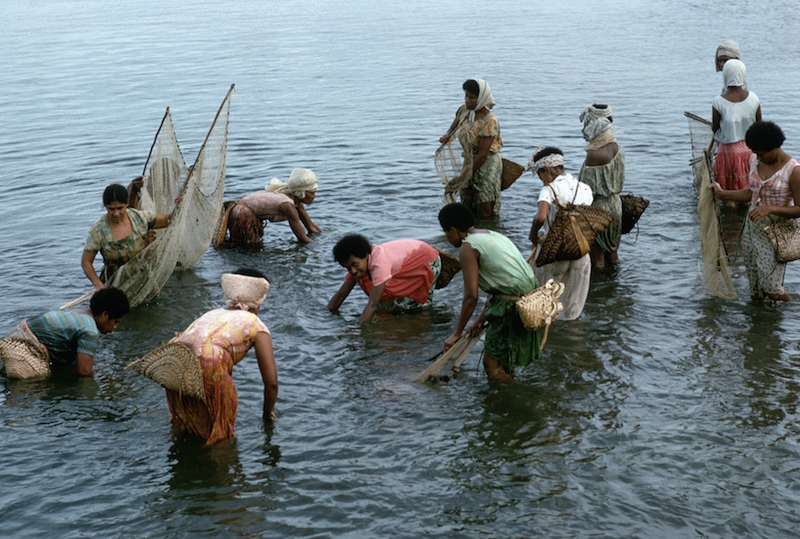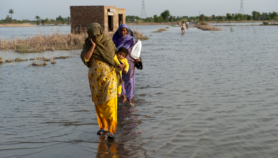Send to a friend
The details you provide on this page will not be used to send unsolicited email, and will not be sold to a 3rd party. See privacy policy.
Women bear brunt of climate change hardships and Pacific island nations pay lip service to equality.
As governments, civil society groups, academics and development partners prepare for UN climate talks in Paris (COP 21), recognising the gender dimension of climate change is vital to an integrated policy and programmatic response to addressing the vulnerabilities of Pacific Island peoples to climate change.
Pacific Island countries are bearing the brunt of climate change. Over the past 50 years, air temperatures across the Pacific have increased by 0.9 degree Celsius while sea surface temperatures have increased by 1.0-1.5 degrees, far above the 0.6 degree Celsius global average. The number of category 4 or 5 storms has also doubled compared to the period 1975-1989.
Sea level rise has reached about 12 millimetres per year in 1993-2009, about four times the global average. Sea level rise alone puts the very existence of low-lying Pacific Islands at risk. With more than 50 per cent of the population and most infrastructures concentrated within 1.5 kilometres of the shore, climate change is a real and important threat to the livelihoods and sustainable development of Pacific people. [1,2]
But the multidimensional effects of climate change are likely to affect men and women differently. For example, it may threaten livelihoods and food production, generate migration and increase the burden of unpaid work. They may aggravate existing inequalities in terms of access to resources, information and decision making, seriously risking setting back key gender equality gains.
Aggravating existing vulnerabilities
Women in the Pacific Island region are already highly vulnerable to hardships due to limited employment opportunities and lack of institutional social protection, with many relying on subsistence farming or remittances from relatives. For instance, in the Solomon Islands, Tonga and Vanuatu, families headed by women in both urban and rural areas are more likely to be with no source of income than families headed by men, leaving them vulnerable to external shocks. [3]
Climate change impacts and the strain they put on traditional sources of livelihood, may significantly challenge men’s ability to provide for their families. Increasing ocean temperatures are already affecting warm water corals on which many Pacific Island families depend for livelihood. Such hardships can trigger and intensify partner conflict and violence, which is one of the most pervasive forms of gender inequality in the Pacific, and increase the reliance of families on women’s subsistence farming or income generated from micro- and small businesses.
In addition, without the necessary adaptation and mitigation efforts, climate change may cost the Pacific region 2.2–3.5 per cent of its annual GDP by 2050, thus reducing government sources of revenue. This will impact public spending on health, education and other social policy expenses that underpin many of the gender equality gains made in the region.
Skills and knowledge untapped Pacific Island women, given their role in fisheries and agriculture, tend to develop a precise knowledge of the subtle changes occurring in their natural environments. In the face of disasters such as the recent tropical cyclone that affected the Solomon Islands and Vanuatu, rural women have been seen as being more risk aware than men, and as taking more responsibility for other family members. [4]
“Only by addressing specific vulnerabilities linked to gender can Pacific Island countries hope to meet one of the most daunting challenges of this century.”
By Kuiniselani Toelupe Tago-Elisara of of the Secretariat of the Pacific Community
These local observations are echoed by researches showing that the inclusion of women at all levels of decision-making leads to a more inclusive analysis of the risks and opportunities posed by climate change, resulting in better overall preparedness.
Complementing the search for scientific and technological solutions to climate change with solutions that are centred on people and their ability to adapt is essential. However, women are often excluded from participation in formal decision-making processes and their needs and perspectives are rarely sought.
A regional report of the Secretariat of the Pacific Community (SPC) assessing progress in 20 years of implementation of the Beijing Platform for Action also showed that commitments to gender-sensitive climate change programmes often remain rhetoric only, and that words are slow to translate into concrete changes in policy and practices.
The draft Strategy for Climate and Disaster Resilient Development in the Pacific, developed by CROP agencies under the leadership of SPC, has adopted inclusive wording, which is raising hopes for better inclusion of gender issues in the new Pacific-wide response strategy.
Renewed commitment to gender equality is needed to maintain a clear focus on key aspects of women’s lives, including sexual and reproductive health, combating violence against women, and working harder to systematically include women in strategies and plans to mitigate the effects of climate change.
Only by addressing specific vulnerabilities linked to gender can Pacific Island countries hope to meet one of the most daunting challenges of this century.
Kuiniselani Toelupe Tago-Elisara is deputy director of gender, culture and youth in the social development division of the Secretariat of the Pacific Community (SPC). Before joining SPC in February 2015, she was a senior executive in the government of Samoa, providing strategic oversight on gender equality, youth development, child protection, disability, community development and local governance.
This article has been produced by SciDev.Net's South-East Asia & Pacific desk.
References
[1] Pacific-Australia Climate Change Science and Adaptation Planning Program Climate Variability, Extremes and Change in the Western Tropical Pacific: New Science and Updated Country Reports (Australian Bureau of Meteorology and CSIRO, 2014)
[2] Intergovernmental Panel on Climate Change Climate Change 2014: Synthesis Report (IPCC, 2014)
[3] Secretariat of the Pacific Community Beijing+20: Review of progress in implementing the Beijing Platform for Action in Pacific Islands countries and territories (SPC, 2014)
[4] Heike Bill Weaving a culture of resilience: A gender-sensitive approach to disaster risk reduction in Vanuatu and the Solomon Islands (European Commission and French Red Cross, 2012)














